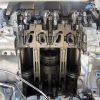How to diagnose a faulty Common Rail injector
Date
14/10/2024
Category
If your customer has experienced any of the above issues, and you suspect the Common Rail diesel injector is at fault, it’s important to conduct a thorough diagnosis to pinpoint the exact cause:
- Identify the fault code: The first stage in identifying Common Rail faults is to interrogate the vehicle’s OBD. By using a quality all makes diagnostic tool such as Delphi’s DS solution, you’ll be able to quickly identify the fault codes and narrow down your diagnosis.
- Check the injectors: If the OBD has generated a fuel injection system fault code, then check the injector’s functionality. Tools such as Delphi’s Sealed Rail Diagnostic Kit can be connected to the injectors, preventing the need for a complete system removal and refit. It collects and measures back leakage flow from the injectors and indicates which injector may be faulty and in need of replacement. By replacing individual injectors rather than a whole set, garages can save both time and money.
- Check the Common Rail pump function: Next fit the Sealed Rail Kit directly onto the high-pressure outlet pipe from the pump and crank the engine to record pressure in the system. The Sealed Rail Kit displays the results digitally and if the figure differs from the specified pressure measurement for the vehicle application, the pump could be faulty.
- Confirm if a mechanical or electrical pump fault: If the Common Rail pump is suspected of being faulty, use Delphi’s False Actuator Kit in conjunction with the Sealed Rail for further interrogation. This temporarily replaces the vehicle’s actuator to enable the pump to generate full system pressure. If the pump generates the correct pressure with the False Actuator in place, then the vehicle actuator is likely to be at fault and should be replaced. However, if the pressure is still below the required level, then the Common Rail pump may have a mechanical fault and should be repaired or replaced.
- Test the injectors electrical integrity: Using Delphi’s Electronic Injector Test Kit, you can test for an open coil circuit and a coil internal short circuit, check the coil insulation to the injector body and measure the coil’s resistance and inductance with just one tool. This will allow you to quickly and easily identify any electronic failures, both on or off the vehicle. Note if a Common Rail solenoid injector has an electronic fault, it cannot be repaired.
- Diagnose and resolve early stage lacquering: If no faults are identified during the above tests, it’s a good sign that valve lacquering is present. By performing a ‘buzz’ test, the Electronic Injector Test Kit will also allow you to check if the injector is moving freely. If not, simply use together with the Injector Solvent Cleaning Kit to clean any lacquering on the valve.
[su_posts posts_per_page="3" tax_term ="6" order ="desc"]
Recent Comments
No comments to show.
Posts Widget
Social Media
Address:
Hangzhou Common Diesel Auto Parts Co.,Ltd
Room 401,Unit 2,Building 1,Xiaoshan District Urban Sunshine Plaza, Xiaoshan District, Hangzhou, Zhejiang,China
Copyright 2024





